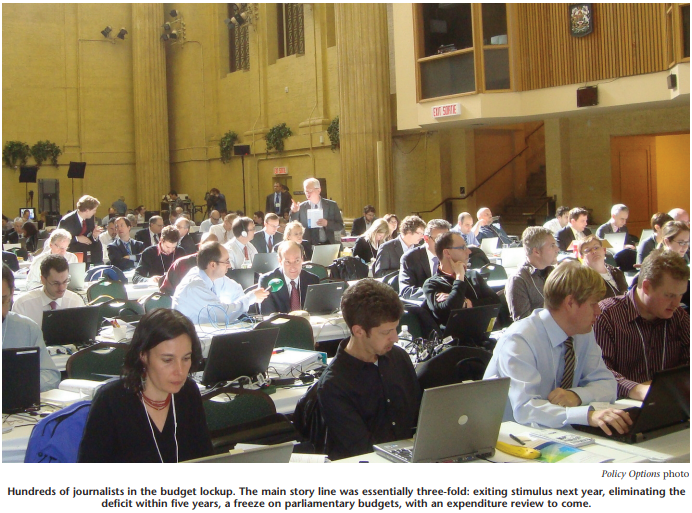
When federal Finance Minister Jim Flaherty concluded his budget speech in the House of Commons on March 4, it is said that the Parliamentary Press Gallery headline writers were left scratching their heads. How would they summarize the Minister’s speech for the morning front page? What was the story of the 2010 budget?
Later that evening, as official Ottawa’s hacks and flacks gathered at Hy’s, the capital’s most famous watering hole, a consensus emerged that, compared to the first four Flaherty budgets, the 2010 vintage was largely a “no news” budget. Devoid as it was of clever poison pills designed to engineer an election, or spectacular announcements to herald a major shift in government direction, it would be difficult indeed to turn this policy statement into sustainable fodder for the 24-hour news machine. Nor would it provide any meaningful clues as to the remaining shelf life of the current Parliament or the timing and trigger of the next election.
In this way at least, the budget was probably a disappointment for assignment editors and political columnists across the country. As shown by the most recent Nanos Research poll, it has not had a significant impact on party preference numbers, and has not reshaped the narrative of our national politics. But beyond what it says — and doesn’t say — about the next election, the budget does tell a political and a policy story that is likely to have a more lasting impact than early reviews suggest.
Coming out of the global recession, and facing a record deficit, this latest Flaherty budget had to meet a number of political and policy objectives. First, with the economic recovery still fragile and the second half of the stimulus package still to come, the government had to avoid triggering an election before it could wrap up its response to the recession and establish a record on the success of these initiatives. Second, following the criticism of the 2009 budget and economic stimulus package from the Conservative Party rank and file, the 2010 budget had to signal a clear transition out of stimulus and a return to fiscal conservatism. Finally, the government had to take policy advantage of the enduring party-preference deadlock in public opinion surveys. Without a clear advantage, the Liberals would not likely defeat the government on the budget; but the same would not necessarily be true in 2011, at which time the life of this minority Parliament would be approaching two and a half years. Beyond public finances and fiscal restraint, 2010 might well be the government’s last best chance to have an impact on the size and role of the federal government in future and introduce changes to the manner in which Canada’s economy is governed.
On these three key objectives, the 2010 budget hits the mark.
First, the “stay the course” approach to budget making presented the Liberals with few targets on which to focus their opposition. Indeed, Liberal Leader Michael Ignatieff spared little time in confirming that, while his caucus would not support the government’s budget, they would not vote in sufficient numbers to bring it down. Rather than critique the budget’s content, the Liberals found that the most potent line of attack was instead to ask whether there was anything in it that justified Harper’s prorogation of Parliament — “You needed six weeks of ‘recalibration’ for this?!?” — and even that criticism did not survive much past the first week back.
Having dodged the election bullet, the government will now be free to implement the second phase of its stimulus package and face voters only once these temporary measures have by and large been wound down. And with employment and growth figures improving with each passing month, the government will be in a stronger position to make the political case to the electorate that Canada weathered the global economic storm better than most, that the recovery has taken hold and that the country is coming out of the recession in a stronger position than any of its G7 partners.
Strategically, the most significant advantage of delaying the election will be the government’s ability to speak of its Economic Action Plan in the past tense. Had an election been triggered this spring, the Conservatives would have had to campaign on a pledge that their economic policy would yield the desired outcomes while the opposition blamed them for the slow pace of recovery. The subtext would necessarily have been “Our plan is working; trust us to finish what we started.” In contrast, a post-recovery campaign can focus on decisions made and actions taken, with hard data and comparative statistics to support the argument. Faced with increasingly positive growth forecasts, the Liberals will be forced to find fault with the government’s approach precisely at the time at which voters will likely begin to feel the recovery, or to cede the economic policy ground to the Conservatives and campaign on a different issue.
Infrastructure or sectoral investment programs could well have created the rationale for new government spending to support operations or sustain particular industries in transition. In all cases, the government resisted the call for some of these initiatives to be made permanent, which reinforced the argument made to the base that stimulus spending was a necessary evil to respond to events outside the government’s control.
Budget 2010 does more than simply delay a rendezvous at the ballot box, however. In many ways, it reestablishes the narrative the Conservatives had been building in budgets past, before the recession imposed its detour into record deficits and spending.
When the Harper government unveiled its response to the recession a year ago, the most biting criticism came not from the benches of the opposition, whose own proposals closely mirrored the main planks of the Economic Action Plan, but from the Conservative Party’s base, who felt betrayed by what they saw as their government’s most un-Conservative budget. The government’s insistence that the measures would be temporary notwithstanding, many Conservative voters and commentators saw in the 2009 budget the proof point that the Harper Tories had moved too far to the centre since taking office.
In contrast, Budget 2010 provides reassurances to the party’s base that 2009 was indeed the exception. First, it confirms that the stimulus measures are temporary and will be wound down by March 31, 2011. There was always a risk that specific measures would be habit-forming and thus be difficult to cancel. The popularity of the renovation tax credit, for example, could have led to the measure becoming permanent in a bid to boost Conservative Party fortunes. In other instances, infrastructure or sectoral investment programs could well have created the rationale for new government spending to support operations or sustain particular industries in transition. In all cases, the government resisted the call for some of these initiatives to be made permanent, which reinforced the argument made to the base that stimulus spending was a necessary evil to respond to events outside the government’s control.
Putting an end to stimulus spending was certainly an essential component in winning back the doubters in the short term. But the choices the government would make in drawing the road map back to balanced budgets would speak volumes about the longerterm ideological orientation of the government. For instance, in taking tax increases off the table immediately and recommitting to its corporate tax reduction timetable, the government reaffirmed its conservative credentials. Moreover, in announcing that it would not touch transfers to individuals or provinces, it also reaffirmed its commitment to respecting the primary role of provinces in the delivery of health and social services and created a sharp contrast with the decisions made by the Chrétien government 15 years prior in its own fight against the deficit. Finally, in targeting government spending and announcing a comprehensive review of administrative costs, the government signalled clearly that, just as a number of businesses and organizations had had to make sacrifices in the last year, the public sector would also have to do its share to bring public spending under control. In the fight against the deficit, government would not be spared.
When it comes to public finances, perhaps the most politically significant aspect of the 2010 budget is the five-year projection that tracks how the government intends to reduce the deficit to $1.8 billion by fiscal year 2014/15. More than any specific pledge, that graph has now set a new frame around the policy choices governments will make in the next decade and the policy options each party will put to the electorate. And while economists will no doubt debate the assumptions made on economic growth and projected tax revenues for many months to come, pooling the advice of no fewer than 15 senior economists on the five-year projections was smart politics. Having made such a public statement of the fact that Finance officials reached out and sought the best advice available from a variety of sectors to chart their projections, the Minister has gone a long way toward inoculating the government against the unforeseen twists and turns in economic performance. At a minimum, if the assumptions turn out to be wrong on growth projections or anticipated revenue, the Minister will at least be in good company!
The decisions made in this year’s budget will certainly have allowed the government to press the reset button on its supporters’ perceptions of its economic policy. Having survived the exception that was 2009, the government is now recommitting to the policy track it started laying when it took office in 2006, and it is perhaps in this way that the 2010 budget will have its most significant impact in the long term.
First, the priority placed on government expenditure in its cost-cutting plan will significantly reduce any future government’s room to manoeuvre, particularly in creating new programs. Without raising taxes or delaying deficit reduction, it is difficult to see how a future government could, for instance, create a national child care program, thereby putting any such policy initiatives virtually out of reach until fiscal balance is restored. After years of fighting Liberals on nuance and emphasis, the Conservatives are now setting up a much sharper contrast in the two parties’ vision of the role and scope of the federal government.
On the economy, the budget’s emphasis on innovation and competitiveness returns the government to the themes it first outlined in its Advantage Canada policy document in 2006, and to the recommendations made by the Competition Policy Review Panel in 2008. While the priority remains job creation in the short-term, Budget 2010 establishes the stimulus budget as the outlier and allows the government to transition back to its core themes of increasing consumer choice, further liberalizing the economy and making Canadian companies more competitive. In particular, the decision to ease foreign investment restrictions in sectors such as satellites and telecommunications has the potential to alter the landscape significantly in these important sectors of the economy. Moreover, it challenges traditional Canadian assumptions about our ability to compete against foreign companies and quite aggressively rejects the longstanding argument on the dangers of the hollowing-out of corporate Canada. The more muscular approach that the government has taken to Canada’s foreign and defence policy will now be applied to the economy as well.
To be sure, Budget 2010 leaves a great deal of work unfinished. Many difficult decisions will have to be made in the next two years to meet the costcutting targets set out in the speech, and there is still a great deal of uncertainty regarding our future economic performance. But on the politics of it, this is both a smart and a clever budget. It is clever in that it provides precious few targets for criticism or controversy. It sends the message that the government neither is seeking to trigger an election, nor is it trying to avoid one at all costs. In making choices on how to bring balance back to the government’s finances, it also sets the frame around future debate and, at least in the short term, binds future governments to the Conservative view of the appropriate role and size of the federal government.
It is also a smart budget in that it takes advantage of the political dynamics to make potentially significant changes to the management of our economy, and eliminates the possibility that the provinces will once again bear the brunt of federal spending cuts. Over time, these decisions are likely to prove themselves to be sound policy, not just smart politics. And while they may not easily translate into attention-grabbing headlines, they say a great deal about the philosophy of a government and tend to be the stuff around which a government’s legacy can be built.
Photo: Shutterstock









